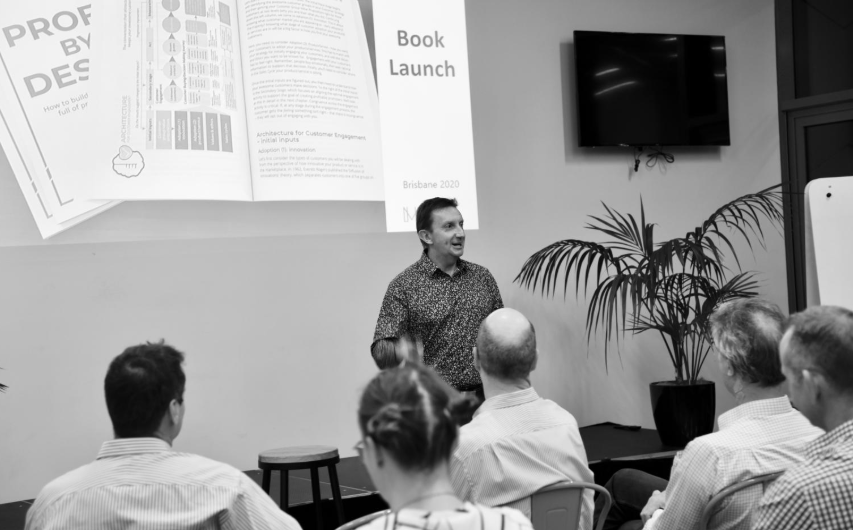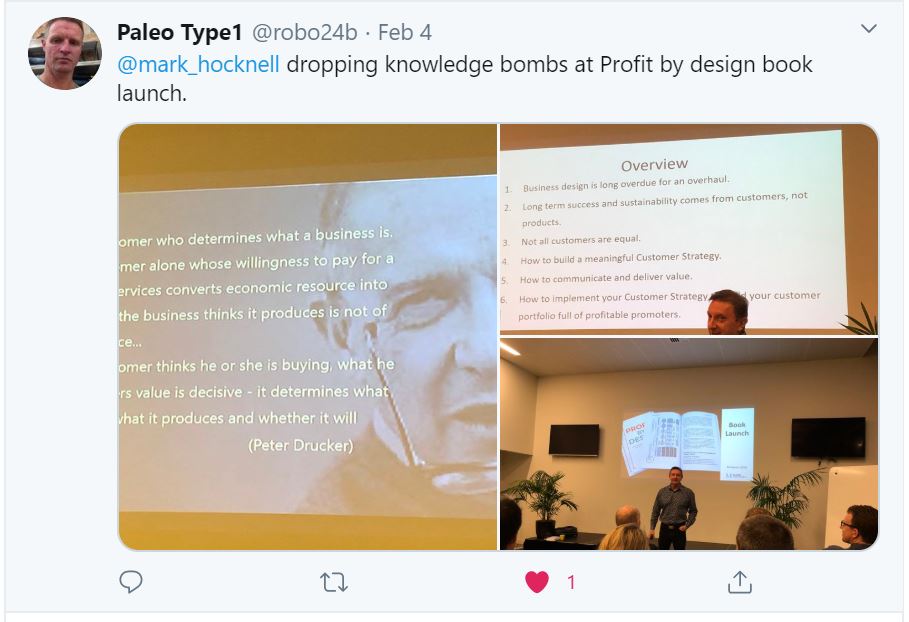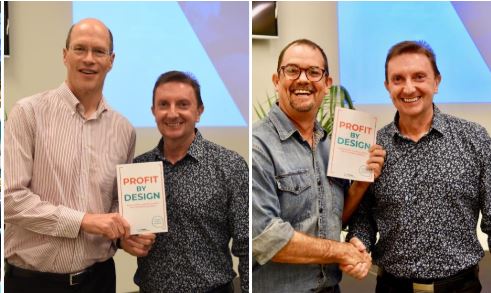Profit by Design: How to build a customer portfolio full of profitable promoters was launched in Brisbane City on Tuesday 4th February 5:30pm at Fishburners.
An awesome crowd turned out for the Profit by Design book launch, along with a few snacks and refreshments, the book was ‘officially’ launched.

Profit by Design Book Launch Overview
The presentation covered six key themes that are dealt with in Profit by Design.
- Business design is long overdue for an overhaul.
- Long term success and sustainability comes from customers, not products.
- Not all customers are equal.
- How to build a meaningful Customer Strategy.
- How to communicate and deliver value.
- Implement your Customer Strategy to build your customer portfolio full of profitable promoters.

Business design is long overdue for an overhaul.
In the early days of commerce and trade, everything was based on relationships, networks, referrals, trust and a mutual exchange of value. Trade routes developed based on these principles. Multi-generational relationships were developed between traders and merchants. Every local producer that had more than they could use, exchanged their goods or produce with other locals.
Networks of people exchanging goods based on trust and a fair, mutual exchange of value.
These are the key principles of human to human trade. They are the same principles driving commerce and trade today. We are happy to pay any price – as long as we feel there is a fair exchange of value.
But something happened during the industrial revolution. From the late 1700’s and well into the 1800’s entrepreneurs became businesses that could produce far more than they could move through their existing networks. Modern sales and marketing were born. “Intrude into where your potential customers are, and get them to buy your stuff!”
For the last two hundred years these ideas have driven business. But today our customers have changed. Customers are more informed than ever. They have had enough of being sold to.
People drive commerce today and it is still driven by relationships, referrals and a mutual exchange of value.
We need to let go of many of the business ideas from the industrial age. They are no longer valid.
Business design is long overdue for an overhaul. And that is what Profit by Design is about.
Long term success and sustainability comes from customers, not products.
The idea from the industrial age was that you monitor revenue (dollars) track you costs and the difference is the profit you make. Today’s world does not follow the same rules as these old P&L accounting models.
Value for the business today comes in two primary forms. Economic value from customers. And advocacy from customers.
We tend to look at the economic value for customers in the form of lifetime value. Not the value of the transaction exchange. How long your customers stay with you and how often they repurchase or resubscribe is critical.
Customer advocacy today ensures the success (or not) of every business. Just like it always has. Only today the customer’s voice has a much bigger reach. We typically measure advocacy with Net Promoter Score.
Advocacy is based on the customer’s perception of a fair exchange of value.
Therefore, it is the construct of your customer portfolio that is the most important element for the design of the business (for profit, or not-for-profit).
This is the subtitle of Profit by Design – how to build a customer portfolio full of profitable promoters.

Not all customers are equal.
When we look at our businesses from the perspective of the various customers that make up the portfolio, we quickly recognise that not all customers are equal.
They are not equal in the following ways:
- The way they perceive the value they receive from the business
- In the value they return to the business – both economic and in the form of advocacy
- How they stay, repurchase, or re-subscribe.
Therefore, each business needs to focus on how the customer portfolio is created.
Most businesses allow any customers into their portfolio. As long as they are prepared to pay for a product/service they can come in. But what if they are not a good fir of the business long term – economically, or in word of mouth.
Most businesses are great examples of the Pareto Principle, where 80 percent of their value comes from 20 percent of their customers. Why do businesses carry 80 percent of customers that do not add much value, but also do not get the value the business offers…? Because the business is just focused on revenue, get a sale and it will be okay. False economics today.
Every business needs to focus on how the customer portfolio is created. And the best way to do this is to develop a customer strategy.
How to build a meaningful Customer Strategy.
A meaningful customer strategy is not based on some quaint statements along the lines of “everything we do is in the best interest of our customers”. A meaningful customer strategy is based on a deep understanding of the various types or groups of customers you have. And then develops an intent for each of these customer groups.
Essentially the process for developing your Customer Strategy is to:
- Identify the various customer groups you have. Start with the higher types of customers, then develop sub-groups. The sub-groups will be based on the differences in how they behave and interact with you.
- Analyse and understand the two-way value exchange between you and the various customer groups.
- Determine your strategy or intent with each customer group. Do you need to re-engineer the relationship with a particular group? Which are the customers you want to grow – which ones need to be a larger portion of your customer portfolio?
This is an iterative process.
Do not let yourself get suck in analysis paralysis.
This post will give you more insight into a meaningful Customer Strategy.
This is the Profit by Design book page – where you can download the first two chapters of the book (for free, no sign in), and chapter two describes more about the Customer Strategy.
How to communicate and deliver value.
Much as been written on how to develop value propositions and sell. However, most of these approaches are about telling customers about what you do and why they should buy from you.
We know now that customers make purchasing decisions based on feelings from the memory and feeling part of the mammalian brain. It doesn’t use words, it uses feelings. When people have to explain their decisions, the mind switches over to the executive function of the brain, where logic and rationale resides. When people explain their decisions, they are telling what they felt was the decision-making process.
People make decisions emotionally, but explain them with logic.
Therefore, when it comes to communicating value, we first must connect on values and principles, demonstrate what we stand for and why customers should listen to us. I call this the Level 1 Value Proposition. Then, when they have chosen to listen, we can demonstrate the value we can deliver for customers, the Level 2 Value Proposition.

Implement your Customer Strategy to build your customer portfolio full of profitable promoters.
Firstly, implementation is not a one-off exercise.
You will start with your practical (not perfect) Customer Strategy and begin implementation. This will be fine-tuning all of your current activity in customer engagement and aligning it to the outcome of having a customer portfolio full of profitable promoters.
Your Customer Strategy becomes your guidebook for how you align your resources to maximise your results: the improved value of your customer portfolio.
You will also need to measurement system in place so that you can continue to learn about what is working on your implementation journey.
The ongoing implementation will require elements of management change. You are shifting from an old business model that focuses on revenue growth and cost management, to one that improves the value of your customer portfolio. People will be unsure about the change. You will need to stay the course. Communicate the Customer Strategy, ensure your KPIs are aligned with the strategy.
Stay on course.
Keep learning and moving forward.
The goal is a customer portfolio full of profitable promoters of what you do.
A couple of more photos from Profit by Design book launch.

Learn more about Profit by Design on the book page or in this companion blog post.
Photo Credit:
Featured Image by Austin Distel on Unsplash



